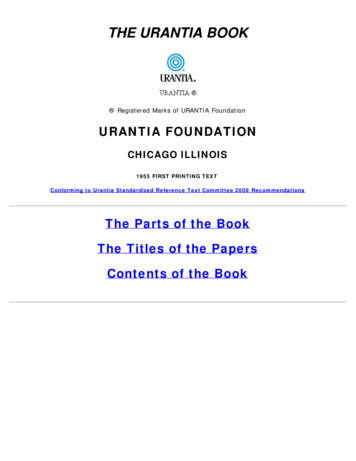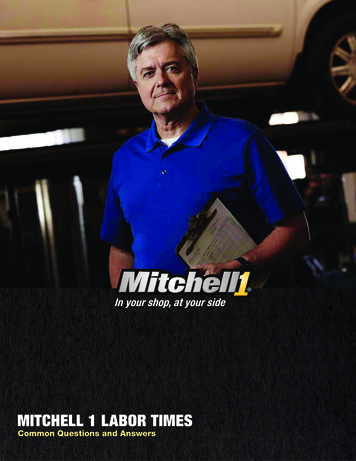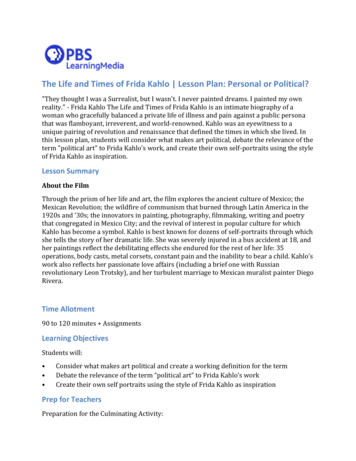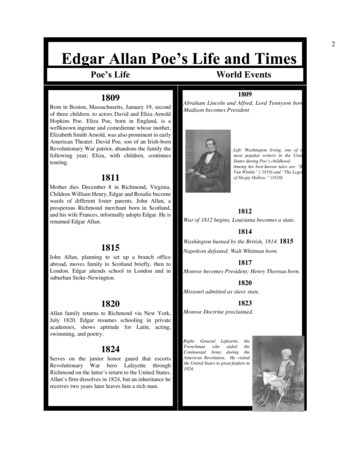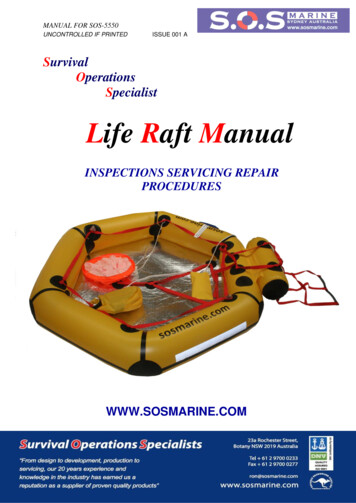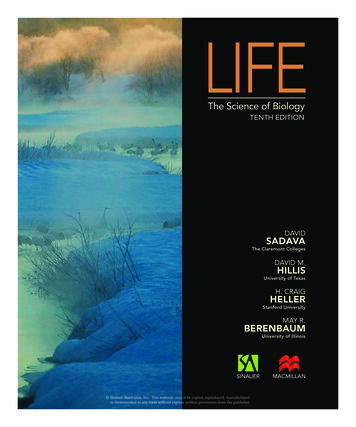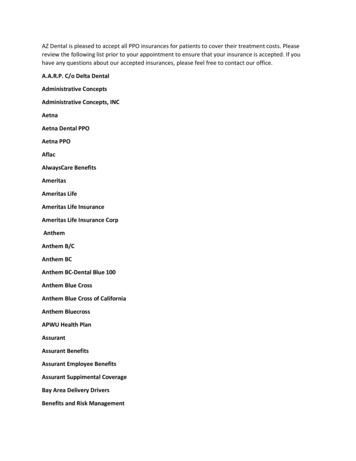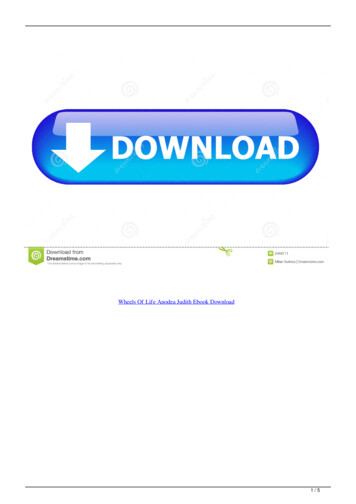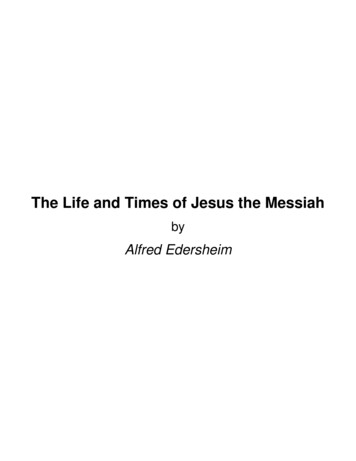
Transcription
The Life and Times of Jesus the MessiahbyAlfred Edersheim
About The Life and Times of Jesus the Messiah by Alfred EdersheimTitle:URL:Author(s):Publisher:Print Basis:Rights:Status:Contributor(s):CCEL Subjects:LC Call no:LC Subjects:The Life and Times of Jesus the s.htmlEdersheim, Alfred (1825-1889)Grand Rapids, MI: Christian Classics Ethereal LibraryWm. B. Eerdmans, 1953Public DomainThis text has been proofread and corrected. Hebrew text has not beenentered.Dr. Chris Benner (Digitizer)All; Classic; History;BT301Doctrinal theologyChristologyLife of Christ
The Life and Times of Jesus the MessiahAlfred EdersheimTable of ContentsAbout This Book. . . . . . . . . . . . . . . . . . . . . . . . . . . . . . . . . . . . . . p. iiTitle Page. . . . . . . . . . . . . . . . . . . . . . . . . . . . . . . . . . . . . . . . . . p. 1Preface to the First Edition. . . . . . . . . . . . . . . . . . . . . . . . . . . . . . . p. 2Preface to the Second and Third Editions. . . . . . . . . . . . . . . . . . . . . . p. 8List of Authorities. . . . . . . . . . . . . . . . . . . . . . . . . . . . . . . . . . . . . p. 12List of Abbreviations and References to Rabbinic Writings. . . . . . . . . . p. 473Introductory. The Preparation for the Gospel; the Jewish world in the daysof Christ. . . . . . . . . . . . . . . . . . . . . . . . . . . . . . . . . . . . . . . . . . . p. 478CHAPTER I. THE JEWISH WORLD IN THE DAYS OF CHRIST - THEJEWISH DISPERSION IN THE EAST. . . . . . . . . . . . . . . . . . . . . . . p. 478CHAPTER II. THE JEWISH DISPERSION IN THE WEST - THEHELLENISTS - ORIGIN OF HELLENIST LITERATURE IN THE GREEKTRANSLATION OF THE BIBLE - CHARACTER OF THESEPTUAGINT. . . . . . . . . . . . . . . . . . . . . . . . . . . . . . . . . . . . . . p. 488CHAPTER III. THE OLD FAITH PREPARING FOR THE NEW DEVELOPMENT OF HELLENIST THEOLOGY: THE ICWRITINGS. . . . . . . . . . . . . . . . . . . . . . . . . . . . . . . . . . . . . . . . p. 499CHAPTER IV. PHILO OF ALEXANDRIA, THE RABBIS, AND THEGOSPELS - THE FINAL DEVELOPMENT OF HELLENISM IN ITSRELATION TO RABBINISM AND THE GOSPEL ACCORDING TO ST.J O H N . . . . . . . . . . . . . . . . . . . . . . . . . . . . . . . . . . . . . . . . . . . . p. 505CHAPTER V. ALEXANDRIA AND ROME - THE JEWISH COMMUNITIESIN THE CAPITALS OF WESTERN CIVILISATION. . . . . . . . . . . . . . p. 518CHAPTER VI. POLITICAL AND RELIGIOUS LIFE OF THE JEWISHDISPERSION IN THE WEST - THEIR UNION IN THE GREAT HOPE OFTHE COMING DELIVERER. . . . . . . . . . . . . . . . . . . . . . . . . . . . . p. 529CHAPTER VII. IN PALESTINE - JEWS AND GENTILES IN 'THE LAND' THEIR MUTUAL RELATIONS AND FEELINGS - 'THE WALL OFSEPARATION.'. . . . . . . . . . . . . . . . . . . . . . . . . . . . . . . . . . . . . . p. 536CHAPTER VIII. TRADITIONALISM, ITS ORIGIN, CHARACTER, ANDLITERATURE - THE MISHNAH AND TALMUD - THE GOSPEL OF CHRIST- THE DAWN OF A NEW DAY. . . . . . . . . . . . . . . . . . . . . . . . . . . . p. 543From the Manger in Bethlehem to the Baptism in Jordan. . . . . . . . . . . p. 556CHAPTER I. IN JERUSALEM WHEN HEROD REIGNED. . . . . . . . . . p. 556iii
The Life and Times of Jesus the MessiahAlfred EdersheimCHAPTER II. THE PERSONAL HISTORY OF HEROD - THE TWOWORLDS IN JERUSALEM. . . . . . . . . . . . . . . . . . . . . . . . . . . . . . p. 563CHAPTER III. THE ANNUNCIATION OF ST. JOHN THE BAPTIST. . . . . p. 571CHAPTER IV. THE ANNUNCIATION OF JESUS THE MESSIAH, ANDTHE BIRTH OF HIS FORERUNNER. . . . . . . . . . . . . . . . . . . . . . . p. 579CHAPTER V. WHAT MESSIAH DID THE JEWS EXPECT?. . . . . . . . . p. 590CHAPTER VI. THE NATIVITY OF JESUS THE MESSIAH. . . . . . . . . p. 606CHAPTER VII. THE PURIFICATION OF THE VIRGIN AND THEPRESENTATION IN THE TEMPLE. . . . . . . . . . . . . . . . . . . . . . . . . p. 616CHAPTER VIII. THE VISIT AND HOMAGE OF THE MAGI, AND THEFLIGHT INTO EGYPT. . . . . . . . . . . . . . . . . . . . . . . . . . . . . . . . . p. 623CHAPTER IX. THE CHILD-LIFE IN NAZARETH. . . . . . . . . . . . . . . . p. 634CHAPTER X. IN THE HOUSE OF HIS HEAVENLY, AND IN THE HOMEOF HIS EARTHLY FATHER - THE TEMPLE OF JERUSALEM - THERETIREMENT AT NAZARETH. . . . . . . . . . . . . . . . . . . . . . . . . . . . p. 647CHAPTER XI. IN THE FIFTEENTH YEAR OF TIBERIUS CÆSAR ANDUNDER THE PONTIFICATE OF ANNAS AND CAIAPHAS - A VOICE INTHE WILDERNESS . . . . . . . . . . . . . . . . . . . . . . . . . . . . . . . . . . p. 661CHAPTER XII. THE BAPTISM OF JESUS: ITS HIGHER MEANING. . . . p. 676The Ascent: From the River Jordan to the Mount of Transfiguration. . . . . p. 686CHAPTER I. THE TEMPTATION OF JESUS. . . . . . . . . . . . . . . . . . p. 686CHAPTER II. THE DEPUTATION FROM JERUSALEM - THE THREESECTS OF THE PHARISEES, SADDUCEES, AND ESSENES EXAMINATION OF THEIR DISTINCTIVE DOCTRINES.[1480]. . . . . . . p. 697CHAPTER III. THE TWOFOLD TESTIMONY OF JOHN - THE FIRSTSABBATH OF JESUS'S MINISTRY - THE FIRST SUNDAY - THE FIRSTDISCIPLES. . . . . . . . . . . . . . . . . . . . . . . . . . . . . . . . . . . . . . . . p. 718CHAPTER IV. THE MARRIAGE FEAST IN CANA OF GALILEE - THEMIRACLE THAT IS 'A SIGN.' . . . . . . . . . . . . . . . . . . . . . . . . . . . . p. 728CHAPTER V. THE CLEANSING OF THE TEMPLE - 'THE SIGN,' WHICHIS NOT A SIGN. . . . . . . . . . . . . . . . . . . . . . . . . . . . . . . . . . . . . . p. 737CHAPTER VI. THE TEACHER COME FROM GOD AND THE TEACHERFROM JERUSALEM - JESUS AND NICODEMUS . . . . . . . . . . . . . . p. 746CHAPTER VII. IN JUDÆA AND THROUGH SAMARIA - A SKETCH OFSAMARITAN HISTORY AND THEOLOGY - JEWS AND SAMARITANS. . . . . . . . . . . . . . . . . . . . . . . . . . . . . . . . . . . . . . . . . . . . . . . . p. 754CHAPTER VIII. JESUS AT THE WELL OF SYCHAR . . . . . . . . . . . . . p. 765CHAPTER IX. THE SECOND VISIT TO CANA - CURE OF THE'NOBLEMAN'S' SON AT CAPERNAUM. . . . . . . . . . . . . . . . . . . . . . p. 777iv
The Life and Times of Jesus the MessiahAlfred WORSHIP AND ARRANGEMENTS. . . . . . . . . . . . . . p. 783CHAPTER XI. THE FIRST GALILEAN MINISTRY. . . . . . . . . . . . . . . p. 798CHAPTER XII. AT THE 'UNKNOWN' FEAST IN JERUSALEM, AND BYTHE POOL OF BETHESDA. . . . . . . . . . . . . . . . . . . . . . . . . . . . . . p. 804CHAPTER XIII. BY THE SEA OF GALILEE - THE FINAL CALL OF THEFIRST DISCIPLES, AND THE MIRACULOUS DRAUGHT OF FISHES. . . . . . . . . . . . . . . . . . . . . . . . . . . . . . . . . . . . . . . . . . . . . . . . p. 812CHAPTER XIV. A SABBATH IN CAPERNAUM . . . . . . . . . . . . . . . . p. 816CHAPTER XV. SECOND JOURNEY THROUGH GALILEE - THE HEALINGOF THE LEPER. . . . . . . . . . . . . . . . . . . . . . . . . . . . . . . . . . . . . p. 823CHAPTER XVI. THE RETURN TO CAPERNAUM - CONCERNING THEFORGIVENESS OF SINS - THE HEALING OF THE PARALYSED . . . . . p. 830CHAPTER XVII. THE CALL OF MATTHEW - THE SAVIOUR'S WELCOMETO SINNERS - RABBINIC THEOLOGY AS REGARDS THE DOCTRINEOF FORGIVENESS IN CONTRAST TO THE GOSPEL OF CHRIST - THECALL OF THE TWELVE APOSTLES. . . . . . . . . . . . . . . . . . . . . . . . p. 836CHAPTER XVIII. THE SERMON ON THE MOUNT - THE KINGDOM OFCHRIST AND RABBINIC TEACHING.[2499] . . . . . . . . . . . . . . . . . . p. 848CHAPTER XIX. THE RETURN TO CAPERNAUM - HEALING OF THECENTURION'S SERVANT. . . . . . . . . . . . . . . . . . . . . . . . . . . . . . p. 861CHAPTER XX. THE RAISING OF THE YOUNG MAN OF NAIN - THEMEETING OF LIFE AND DEATH. . . . . . . . . . . . . . . . . . . . . . . . . . p. 868CHAPTER XXI. THE WOMAN WHICH WAS A SINNER . . . . . . . . . . . p. 875CHAPTER XXII. THE MINISTRY OF LOVE, THE BLASPHEMY OFHATRED, AND THE MISTAKES OF EARTHLY AFFECTION - THERETURN TO CAPERNAUM - HEALING OF THE DEMONISED DUMB PHARISAIC CHARGE AGAINST CHRIST - THE VISIT OF CHRIST'SMOTHER AND BRETHREN . . . . . . . . . . . . . . . . . . . . . . . . . . . . . p. 881CHAPTER XXIII. NEW TEACHING 'IN PARABLES' - THE PARABLES TOTHE PEOPLE BY THE LAKE OF GALILEE, AND THOSE TO THEDISCIPLES IN CAPERNAUM . . . . . . . . . . . . . . . . . . . . . . . . . . . . p. 887CHAPTER XXIV. CHRIST STILLS THE STORM ON THE LAKE OFGALILEE. . . . . . . . . . . . . . . . . . . . . . . . . . . . . . . . . . . . . . . . . . p. 902CHAPTER XXV. AT GERASA - THE HEALING OF THEDEMONISED. . . . . . . . . . . . . . . . . . . . . . . . . . . . . . . . . . . . . . p. 906CHAPTER XXVI. THE HEALING OF THE WOMAN - CHRIST'SPERSONAL APPEARANCE - THE RAISING OF JAIRUS' DAUGHTER. . . . . . . . . . . . . . . . . . . . . . . . . . . . . . . . . . . . . . . . . . . . . . . . p. 912v
The Life and Times of Jesus the MessiahAlfred EdersheimCHAPTER XXVII. SECOND VISIT TO NAZARETH - THE MISSION OFTHE TWELVE. . . . . . . . . . . . . . . . . . . . . . . . . . . . . . . . . . . . . . . p. 926CHAPTER XXVIII. THE STORY OF THE BAPTIST, FROM HIS LASTTESTIMONY TO JESUS TO HIS BEHEADING IN PRISON . . . . . . . . p. 940CHAPTER XXIX. THE MIRACULOUS FEEDING OF THE FIVE THOUSAND. . . . . . . . . . . . . . . . . . . . . . . . . . . . . . . . . . . . . . . . . . . . . . . . p. 955CHAPTER XXX. THE NIGHT OF MIRACLES ON THE LAKE OFGENNESARET. . . . . . . . . . . . . . . . . . . . . . . . . . . . . . . . . . . . . . p. 961CHAPTER XXXI. THE CAVILS OF THE PHARISEES CONCERNINGPURIFICATION, AND THE TEACHING OF THE LORD CONCERNINGPURITY - THE TRADITIONS CONCERNING 'HAND-WASHING' AND'VOWS.' . . . . . . . . . . . . . . . . . . . . . . . . . . . . . . . . . . . . . . . . . . p. 976CHAPTER XXXII. THE GREAT CRISIS IN POPULAR FEELING - THELAST DISCOURSES IN THE SYNAGOGUE OF CAPERNAUM - CHRISTTHE BREAD OF LIFE - 'WILL YE ALSO GO AWAY?' . . . . . . . . . . . . p. 992CHAPTER XXXIII. JESUS AND THE SYRO-PHOENICIAN WOMAN . . . p. 1001CHAPTER XXXIV. A GROUP OF MIRACLES AMONG A SEMI-HEATHENPOPULATION . . . . . . . . . . . . . . . . . . . . . . . . . . . . . . . . . . . . . . p. 1006CHAPTER XXXV. THE TWO SABBATH-CONTROVERSIES - THEPLUCKING OF THE EARS OF CORN BY THE DISCIPLES, AND THEHEALING OF THE MAN WITH THE WITHERED HAND . . . . . . . . . . . p. 1011CHAPTER XXXVI. THE FEEDING OF THE FOUR THOUSAND - TODALMANUTHA - 'THE SIGN FROM HEAVEN' - JOURNEY TO CÆSAREAPHILIPPI - WHAT IS THE LEAVEN OF THE PHARISEES ANDSADDUCEES? . . . . . . . . . . . . . . . . . . . . . . . . . . . . . . . . . . . . . p. 1019CHAPTER XXXVII. THE GREAT CONFESSION - THE GREATCOMMISSION - THE GREAT INSTRUCTION - THE GREAT TEMPTATION- THE GREAT DECISION. . . . . . . . . . . . . . . . . . . . . . . . . . . . . . . p. 1026The Descent: From the Mount of Transfiguration into the Valley of Humiliationand Death. . . . . . . . . . . . . . . . . . . . . . . . . . . . . . . . . . . . . . . . . . p. 1038CHAPTER I. THE TRANSFIGURATION. . . . . . . . . . . . . . . . . . . . . p. 1038CHAPTER II. ON THE MORROW OF THE TRANSFIGURATION. . . . . p. 1046CHAPTER III. THE LAST EVENTS IN GALILEE - THE TRIBUTE-MONEY,THE DISPUTE BY THE WAY, THE FORBIDDING OF HIM WHO COULDNOT FOLLOW WITH THE DISCIPLES, AND THE CONSEQUENTTEACHING OF CHRIST. . . . . . . . . . . . . . . . . . . . . . . . . . . . . . . p. 1051CHAPTER IV. THE JOURNEY TO JERUSALEM - CHRONOLOGICALARRANGEMENT OF THE LAST PART OF THE GOSPEL-NARRATIVES- FIRST INCIDENTS BY THE WAY. . . . . . . . . . . . . . . . . . . . . . . . p. 1063vi
The Life and Times of Jesus the MessiahAlfred EdersheimCHAPTER V. FURTHER INCIDENTS OF THE JOURNEY TO JERUSALEM- THE MISSION AND RETURN OF THE SEVENTY - THE HOME ATBETHANY - MARTHA AND MARY . . . . . . . . . . . . . . . . . . . . . . . . p. 1069CHAPTER VI. AT THE FEAST OF TABERNACLES - FIRST DISCOURSEIN THE TEMPLE . . . . . . . . . . . . . . . . . . . . . . . . . . . . . . . . . . . . p. 1078CHAPTER VII. IN THE LAST, THE GREAT DAY OF THE FEAST'. . . . . p. 1084CHAPTER VIII. TEACHING IN THE TEMPLE ON THE OCTAVE OF THEFEAST OF TABERNACLES. . . . . . . . . . . . . . . . . . . . . . . . . . . . . p. 1090CHAPTER IX. THE HEALING OF THE MAN BORN BLIND. . . . . . . . p. 1100CHAPTER X. THE 'GOOD SHEPHERD' AND HIS 'ONE FLOCK' - LASTDISCOURSE AT THE FEAST OF TABERNACLES. . . . . . . . . . . . . . p. 1108CHAPTER XI. THE FIRST PERÆAN DISCOURSES - TO THE PHARISEESCONCERNING THE TWO KINGDOMS - THEIR CONTEST - WHATQUALIFIES A DISCIPLE FOR THE KINGDOM OF GOD, AND HOWISRAEL WAS BECOMING SUBJECT TO THAT OF EVIL. . . . . . . . . . p. 1113CHAPTER XII. THE MORNING-MEAL IN THE PHARISEE'S HOUSE MEALS AND FEASTS AMONG THE JEWS - CHRIST'S LAST PERÆANWARNING TO PHARISAISM . . . . . . . . . . . . . . . . . . . . . . . . . . . . p. 1119CHAPTER XIII. TO THE DISCIPLES - TWO EVENTS AND THEIR MORAL. . . . . . . . . . . . . . . . . . . . . . . . . . . . . . . . . . . . . . . . . . . . . . . . p. 1127CHAPTER XIV. AT THE FEAST OF THE DEDICATION OF THE TEMPLE. . . . . . . . . . . . . . . . . . . . . . . . . . . . . . . . . . . . . . . . . . . . . . . . p. 1136CHAPTER XV. THE SECOND SERIES OF PARABLES - THE TWOPARABLES OF HIM WHO IS NEIGHBOUR TO US: THE FIRST,CONCERNING THE LOVE THAT, UNASKED, GIVES IN OUR NEED;THE SECOND, CONCERNING THE LOVE WHICH IS ELICITED BY OURASKING IN OUR NEED. . . . . . . . . . . . . . . . . . . . . . . . . . . . . . . . p. 1143CHAPTER XVI. THE THREE PARABLES OF WARNING: TO THEINDIVIDUAL, TO THE NATION, AND TO THE THEOCRACY - THEFOOLISH RICH MAN - THE BARREN FIG-TREE - THE GREAT SUPPER. . . . . . . . . . . . . . . . . . . . . . . . . . . . . . . . . . . . . . . . . . . . . . . . p. 1149CHAPTER XVII. THE THREE PARABLES OF THE GOSPEL: OF THERECOVERY OF THE LOST - OF THE LOST SHEEP, THE LOSTDRACHM, THE LOST SON. . . . . . . . . . . . . . . . . . . . . . . . . . . . . . p. 1156CHAPTER XVIII. THE UNJUST STEWARD - DIVES AND LAZARUS JEWISH AGRICULTURAL NOTES - PRICES OF PRODUCE - WRITINGAND LEGAL DOCUMENTS - PURPLE AND FINE LINEN - JEWISHNOTIONS OF HADES. . . . . . . . . . . . . . . . . . . . . . . . . . . . . . . . . p. 1164vii
The Life and Times of Jesus the MessiahAlfred EdersheimCHAPTER XIX. THE THREE LAST PARABLES OF THE PERÆANSERIES: THE UNRIGHTEOUS JUDGE - THE SELF-RIGHTEOUSPHARISEE AND THE PUBLICAN - THE UNMERCIFUL SERVANT . . . . p. 1180CHAPTER XX. CHRIST'S DISCOURSES IN PERÆA - CLOSE OF THEPERÆAN MINISTRY . . . . . . . . . . . . . . . . . . . . . . . . . . . . . . . . . p. 1189CHAPTER XXI. THE DEATH AND THE RAISING OF LAZARUS - THEQUESTION OF MIRACLES AND OF THIS MIRACLE OF MIRACLES VIEWS OF NEGATIVE CRITICISM ON THIS HISTORY - JEWISHBURYING-RITES AND SEPULCHRES. . . . . . . . . . . . . . . . . . . . . . p. 1197CHAPTER XXII. ON THE JOURNEY TO JERUSALEM - DEPARTUREFROM EPHRAIM BY WAY OF SAMARIA AND GALILEE - HEALING OFTEN LEPERS - PROPHETIC DISCOURSE OF THE COMING KINGDOM- ON DIVORCE: JEWISH VIEWS OF IT - THE BLESSING TO LITTLECHILDREN. . . . . . . . . . . . . . . . . . . . . . . . . . . . . . . . . . . . . . . . p. 1211CHAPTER XXIII. THE LAST INCIDENTS IN PERÆA - THE YOUNGRULER WHO WENT AWAY SORROWFUL - TO LEAVE ALL FOR CHRIST- PROPHECY OF HIS PASSION - THE REQUEST OF SALOME, ANDOF JAMES AND JOHN. . . . . . . . . . . . . . . . . . . . . . . . . . . . . . . . . p. 1218CHAPTER XXIV. IN JERICHO AND AT BETHANY - JERICHO - A GUESTWITH ZACCHÆUS - THE HEALING OF BLIND BARTIMÆUS - THE PLOTAT JERUSALEM - AT BETHANY, AND IN THE HOUSE OF SIMON THELEPER . . . . . . . . . . . . . . . . . . . . . . . . . . . . . . . . . . . . . . . . . . . p. 1226The Cross and the Crown. . . . . . . . . . . . . . . . . . . . . . . . . . . . . . . p. 1235CHAPTER I. THE FIRST DAY IN PASSION-WEEK - PALM-SUNDAY THE ROYAL ENTRY INTO JERUSALEM . . . . . . . . . . . . . . . . . . . . p. 1235CHAPTER II. THE SECOND DAY IN PASSION-WEEK - THE BARRENFIG-TREE - THE CLEANSING OF THE TEMPLE - THE HOSANNA OFTHE CHILDREN . . . . . . . . . . . . . . . . . . . . . . . . . . . . . . . . . . . . p. 1242CHAPTER III. THE THIRD DAY IN PASSION-WEEK - THE EVENTS OFTHAT DAY - THE QUESTION OF CHRIST'S AUTHORITY - THEQUESTION OF TRIBUTE TO CÆSAR - THE WIDOW'S FARTHING - THEGREEKS WHO SOUGHT TO SEE JESUS - SUMMARY ANDRETROSPECT OF THE PUBLIC MINISTRY OF CHRIST . . . . . . . . . p. 1246CHAPTER IV. THE THIRD DAY IN PASSION-WEEK - THE LASTCONTROVERSIES AND DISCOURSES - THE SADDUCEES AND THERESURRECTION - THE SCRIBE AND THE GREAT COMMANDMENT QUESTION TO THE PHARISEES ABOUT DAVID'S SON AND LORD FINAL WARNING TO THE PEOPLE: THE EIGHT 'WOES' - FAREWELL. . . . . . . . . . . . . . . . . . . . . . . . . . . . . . . . . . . . . . . . . . . . . . . . p. 1258viii
The Life and Times of Jesus the MessiahAlfred EdersheimCHAPTER V. THE THIRD DAY IN PASION-WEEK - THE LAST SERIESOF PARABLES: TO THE PHARISEES AND TO THE PEOPLE - ON THEWAY TO JERUSALEM: THE PARABLE OF THE LABOURERS IN THEVINEYARD - IN THE TEMPLE: THE PARABLE OF THE 'NO' AND 'YES'OF THE TWO SONS - THE PARABLE OF THE EVIL HUSBANDMENEVILLY DESTROYED - THE PARABLE OF THE MARRIAGE OF THEKING'S SON AND OF THE WEDDING GARMENT. . . . . . . . . . . . . . p. 1273CHAPTER VI. THE EVENING OF THE THIRD DAY IN PASSION-WEEK- ON THE MOUNT OF OLIVES: DISCOURES TO THE DISCIPLESCONCERNING THE LAST THINGS. . . . . . . . . . . . . . . . . . . . . . . . p. 1285CHAPTER VII. EVENING OF THE THIRD DAY IN PASSION-WEEK-ONTHE MOUNT OF OLIVES-LAST PARABLES: TO THE DISCIPLESCONCERNING THE LAST THINGS-THE PARABLE OF THE TENVIRGINS-THE PARABLE OF THE TALENTS-SUPPLEMENTARYPARABLE OF THE MINAS AND THE KING'S RECKONING WITH HISSERVANTS AND HIS REBELLIOUS CITIZENS . . . . . . . . . . . . . . . . p. 1301CHAPTER VIII. THE FOURTH DAY IN PASSION-WEEK - JESUS IN HISLAST SABBATIC REST BEFORE HIS AGONY, AND THE SANHEDRISTSIN THEIR UNREST - THE BETRAYAL - JUDAS: HIS CHARACTER,APOSTASY, AND END. . . . . . . . . . . . . . . . . . . . . . . . . . . . . . . . p. 1311CHAPTER IX. THE FIFTH DAY IN PASSION-WEEK - 'MAKE READY THEPASSOVER!' . . . . . . . . . . . . . . . . . . . . . . . . . . . . . . . . . . . . . . . p. 1319CHAPTER X. THE PASCHAL SUPPER - THE INSTITUTION OF THELORD'S SUPPER. . . . . . . . . . . . . . . . . . . . . . . . . . . . . . . . . . . . p. 1329CHAPTER XI. THE LAST DISCOURSES OF CHRIST - THE PRAYER OFCONSECRATION.[5716]. . . . . . . . . . . . . . . . . . . . . . . . . . . . . . . p. 1345CHAPTER XII. GETHSEMANE . . . . . . . . . . . . . . . . . . . . . . . . . . . p. 1359CHAPTER XIII. THURSDAY NIGHT - BEFORE ANNAS AND CAIAPHAS- PETER AND JESUS. . . . . . . . . . . . . . . . . . . . . . . . . . . . . . . . . p. 1368CHAPTER XIV. THE MORNING OF GOOD FRIDAY. . . . . . . . . . . . . p. 1382CHAPTER XV. 'CRUCIFIED, DEAD, AND BURIED.' . . . . . . . . . . . . p. 1393CHAPTER XVI. ON THE RESURRECTION OF CHRIST FROM THED E A D . . . . . . . . . . . . . . . . . . . . . . . . . . . . . . . . . . . . . . . . . . . . p. 1422CHAPTER XVII. 'ON THE THIRD DAY HE ROSE AGAIN FROM THEDEAD; HE ASCENDED INTO HEAVEN' . . . . . . . . . . . . . . . . . . . . . p. 1429APPENDICES. . . . . . . . . . . . . . . . . . . . . . . . . . . . . . . . . . . . . . . p. 1446APPENDIX I. Pseudepigraphic Writings. . . . . . . . . . . . . . . . . . . . . . p. 1446APPENDIX II. Philo of Alexandria and Rabbinic Theology. . . . . . . . . . p. 1449APPENDIX III. Rabbinic Views as to the Lawfulness of Images, PictorialRepresentations on Coins, etc. . . . . . . . . . . . . . . . . . . . . . . . . . . p. 1454ix
The Life and Times of Jesus the MessiahAlfred EdersheimAPPENDIX IV. An Abstract of Jewish History from the Reign of Alexanderthe Great to the Accession of Herod. . . . . . . . . . . . . . . . . . . . . . . . p. 1456APPENDIX V. Rabbinic Theology and Literature. . . . . . . . . . . . . . . . p. 1471APPENDIX VI. List of the Maccabees, of the Family of Herod, of theHigh-Priests, the Roman Procurators of Judæa, and Roman Govenors ofSyria. . . . . . . . . . . . . . . . . . . . . . . . . . . . . . . . . . . . . . . . . . . . . p. 1526APPENDIX VII. On the Date of the Nativity of our Lord. . . . . . . . . . . . p. 1527APPENDIX VIII. Rabbinic Traditions about Elijah, the Forerunner of theMessiah. . . . . . . . . . . . . . . . . . . . . . . . . . . . . . . . . . . . . . . . . . p. 1529APPENDIX IX. List of Old Testament Passages Messianically Applied inAncient Rabbinic Writings. . . . . . . . . . . . . . . . . . . . . . . . . . . . . . . p. 1532APPENDIX X. On the Supposed Temple-Synagogue. . . . . . . . . . . . . p. 1567APPENDIX XI. On the Prophecy, Is. XL. 3. . . . . . . . . . . . . . . . . . . . p. 1568APPENDIX XII. The Baptism of Proselytes. . . . . . . . . . . . . . . . . . . . p. 1569APPENDIX XIV. The Law in Messianic Times. . . . . . . . . . . . . . . . . . p. 1587APPENDIX XV. The Location of Sychar, and the Date of our Lord's Visitto Samaria. . . . . . . . . . . . . . . . . . . . . . . . . . . . . . . . . . . . . . . . . p. 1589APPENDIX XVI. On the Jewish Views about 'Demons' and 'The Demonised,'together with some Notes on the Intercourse between Jews and JewishChristians in the First Centuries. . . . . . . . . . . . . . . . . . . . . . . . . . . p. 1592APPENDIX XVII. The Ordinances and Law of the Sabbath as Laid Downin the Mishnah and the Jerusalem Talmud. . . . . . . . . . . . . . . . . . . . p. 1598APPENDIX XVIII. Haggadah about Simeon Kepha (Legent of SimonPeter). . . . . . . . . . . . . . . . . . . . . . . . . . . . . . . . . . . . . . . . . . . . p. 1608APPENDIX XIX. On Eternal Punishment, According to the Rabbis and theNew Testament. . . . . . . . . . . . . . . . . . . . . . . . . . . . . . . . . . . . . p. 1611INDEX I. Of Subjects. . . . . . . . . . . . . . . . . . . . . . . . . . . . . . . . . . . p. 1618INDEX II. Of Passages from the Four Gospels Referred To in theseVolumes. . . . . . . . . . . . . . . . . . . . . . . . . . . . . . . . . . . . . . . . . . . p. 1657Indexes. . . . . . . . . . . . . . . . . . . . . . . . . . . . . . . . . . . . . . . . . . . . p. 1702Index of Scripture References. . . . . . . . . . . . . . . . . . . . . . . . . . . . p. 1702Greek Words and Phrases. . . . . . . . . . . . . . . . . . . . . . . . . . . . . . p. 1711Index of Pages of the Print Edition. . . . . . . . . . . . . . . . . . . . . . . . . p. 1723x
Life and Times of JesusAlfred EdersheimTHELIFE AND TIMESOFJESUS THE MESSIAHBYALFRED EDERSHEIM, M.A.Oxon., D.D. Ph.D.TOTHE CHANCELLOR, MASTERS, AND SCHOLARSOF THE UNIVERSITY OF OXFORDTHESE VOLUMESARE RESPECTFULLY DEDICATED
Life and Times of JesusAlfred EdersheimPREFACETOTHE FIRST EDITION.In presenting these volumes to the reader, I must offer an explanation, - though I would fainhope that such may not be absolutely necessary. The title of this book must not be understood asimplying any pretence on my part to write a ‘Life of Christ’ in the strict sense. To take the lowestview, the materials for it do not exist. Evidently the Evangelists did not intend to give a full recordof even the outward events in that History; far less could they have thought of compassing thesphere or sounding the depths of the Life of Him, Whom they present to us as the God-Man andthe Eternal Son of the Eternal Father. Rather must the Gospels be regarded as four different aspectsin which the Evangelists viewed the historical Jesus of Nazareth as the fulfilment of the Divinepromise of old, the Messiah of Israel and the Saviour of man, and presented Him to the Jewish andGentile world for their acknowledgment as the Sent of God, Who revealed the Father, and wasHimself the Way to Him, the Truth, and the Life. And this view of the Gospel-narratives underliesthe figurative representation of the Evangelist in Christian Symbolism.1In thus guarding my meaning in the choice of the title, I have already indicated my ownstandpoint in this book. But in another respect I wish to disclaim having taken any predetermineddogmatic standpoint at the outset of my investigations. I wished to write, not for a definite purpose,be it even that of the defence of the faith, - but rather to let that purpose grow out of the book, aswould be pointed out by the course of independent study, in which arguments on both sides shouldbe impartially weighed and facts ascertained. In this manner I hoped best to attain what must bethe first object in all research, but especially in such as the present: to ascertain, as far as we can,the truth, irrespective of consequences. And thus also I hoped to help others, by going, as it were,before them, in the path which their enquires must take, and removing the difficulties andentanglements which beset it. So might I honestly, confidently, and, in such a matter, earnestly,ask them to follow me, pointing to the height to which such enquires must lead up. I know, indeed,that there is something beyond and apart from this; even the restful sense on that height, and thehappy outlook from it. But this is not within the province of one man to give to another, nor yetdoes it come in the way of study, however earnest and careful; it depends upon, and implies theexistence of a subjective state which comes only by the direction given to our enquires by the trueͺδηγͺζ (St John xvi. 13).This statement of the general object in view will explain the course pursued in these enquiries.First and foremost, this book was to be study of the Life of Jesus the Messiah, retaining the generaldesignation, as best conveying to others the subject to be treated.But, secondly, since Jesus of Nazareth was a Jew, spoke to, and moved among Jews, inPalestine, and at a definite period of its history, it was absolutely necessary to view that Life andTeaching in all its surroundings of place, society, popular life, and intellectual or religiousdevelopment. This would form not only the frame in which to set the picture of the Christ, but thevery background of the picture itself. It is, indeed, most true that Christ spoke not only to the Jews,1Comp. the historical account of these symbols in Zahn, Forsch. z. Gesch. d. Neu-Test. Kanons, ii. pp. 257-275.2
Life and Times of JesusAlfred Edersheimto Palestine, and to that time, but - of which history has given the evidence - to all men and to alltimes. Still He spoke first and directly to the Jews, and His words must have been intelligible tothem, His teaching have reached upwards from their intellectual and religious standpoint, evenalthough it infinitely extended the horizon so as, in its full application, to make it wide as the boundsof earth and time. Nay, to explain the bearing of the religious leaders of Israel, from the first, towardsJesus, it seemed also necessary to trace the historical development of thought and religious belief,till it issued in that system of Traditionalism, which, by an internal necessity, was irreconcilablyantagonistic to the Christ of the Gospels.On other grounds also, such a full portraiture of Jewish life, society, and thinking seemedrequisite. It furnishes alike a vindication and an illustration of the Gospel-narratives. A vindication- because in measure as we transport ourselves into that time, we feel that the Gospels present tous a real, historical scene; that the men and the circumstances to which we are introduced are real- not a fancy picture, but just such as we know and now recognize them, and would expect themto have spoken, or to have been. Again, we shall thus vividly realise another and most importantaspect of the words of Christ. We shall perceive that their form is wholly of the times, their castJewish - while by the side of this similarity of form there is not only essential difference but absolutecontrariety of substance and spirit. Jesus spoke as truly a Jew to the Jews, but He spoke not as they- no, not as their highest and best Teachers would have spoken. And this contrariety of spirit withmanifest similarity of form is, to my mind, one of the strongest evidences of the claims of Christ,since it raises the all-important question, whence the Teacher of Nazareth - or, shall we say, thehumble Child of the Carpenter-home in a far-off little place of Galilee - had drawn His inspiration?And clearly to set this forth has been the first object of the detailed Rabbinic quotations in thisbook.But their further object, besides this vindication, has been the illustration of theGospel-narratives. Even the general reader must be aware that some knowledge of Jewish life andsociety at the time is requisite for the understanding of the Gospel-history. Those who have consultedthe works of Lightfoot, Schöttgen, Meuschen, Wetstein and Wünsche, or even the extracts fromthem presented in Commentaries, know that the help derived from their Jewish references is verygreat. And yet, despite the immense learning and industry of these writers, there are seriousdrawbacks to their use. Sometimes the references are critically not quite accurate; sometimes theyare derived from works that should not have been adduced in evidence; occasionally, either therendering, or the application of what is separated from its context, is not reliable. A still moreserious objection is, that these quotations are not unfrequently one sided; but chiefly this - perhaps,as the necessary consequence of being merely illustrative notes to certain verses in the Gospels that they do not present a full and connected picture. And yet it is this which so often gives themost varied and welcome illustration of the Gospel-narratives. In truth, we know not only theleading personages in Church and State in Palestine at that time, their views, teaching, pursuits,and aims; the state of parties; the character of popular opinion; the proverbs, the customs, the dailylife of the country - but we can, in imagination, enter their dwellings, associate with them in familiarintercourse, or follow them to the Temple, the Synagogue, the Academy, or to the market-placeand the workshop. We know what clothes they wore, what dishes they ate, what wines they drank,what they produced and what they imported: nay, the cost of every article of their dress or food,the price of houses and of living; in short, every detail that can give vividness to a picture of life.3
Life and Times of JesusAlfred EdersheimAll this is so important for the understanding of the Gospel-history as, I hope, to justify thefulness of archæological detail in this book. And yet I have used only a portion of the materialswhich
The Life and Times of Jesus the Messiah by Alfred Edersheim. This document has been generated from XSL (Extensible Stylesheet Language) source w


